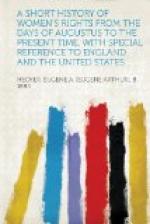In 1865 John Stuart Mill was elected to Parliament. That able thinker had written on The Subjection of Women and was ready to champion their rights. A petition was prepared under the direction of women like Mrs. Bodichon and Miss Davies; and in 1867 Mill proposed in Parliament that the word man be omitted from the People’s Bill and person substituted. The amendment was rejected, 196 to 83.
Nevertheless, the agitation was continued. The next year constitutional lawyers like Mr. Chisholm Anstey decided that women might be legally entitled to vote; and 5000 of them applied to be registered. In a test case brought before the Court of Common Pleas the verdict was adverse, on the ground that it was contrary to usage for women to vote. The fight went on. Mr. Jacob Bright in 1870 introduced a “Bill to Remove the Electoral Disabilities of Women” and lost. In 1884 Mr. William Woodall tried again; he lost also, largely through the efforts of Gladstone; and the same statesman was instrumental in killing another bill in 1892, when Mr. A.J. Balfour urged its passage.
At the present day women in England cannot vote on great questions of universal state policy nor can they hold great offices of state. Yet their gains have been enormous, as I shall next demonstrate; and in this connection I shall also glance briefly at their vast strides in the colonies.
In 1850 Ontario gave all women school suffrage. In 1867 New South Wales gave them municipal suffrage. In 1869 England granted municipal suffrage to single women and widows; Victoria gave it to all women, married or single. In England in 1870 the Education Act, by which school boards were created, gave women the same rights as men, both as regards electing and being elected. In 1871 West Australia gave them municipal suffrage; in 1878 New Zealand gave school suffrage. In 1880 South Australia gave municipal suffrage. In 1881 widows and single women obtained municipal suffrage in Scotland and Parliamentary suffrage on the Isle of Man. Municipal suffrage was given by Ontario and Tasmania in 1884 and by New Zealand and New Brunswick in 1886; by Nova Scotia and Manitoba in 1887. In 1888 England gave women county suffrage and British Columbia and the North-West Territory gave them municipal suffrage. In 1889 county suffrage was given the women of Scotland and municipal suffrage to single women and widows in the Province of Quebec. In 1893 New Zealand gave full suffrage. In 1894 parish and district suffrage was given in England to women married and single, with power to elect and to be elected to parish and district councils. In 1895 South Australia gave full state suffrage to all women. In 1898 the women of Ireland were given the right to vote for all officers except members of Parliament. In 1900 West Australia granted full state suffrage to all. In 1902 full national suffrage was given all the women in federated Australia and full state suffrage to those of New South Wales.




